Previously on the Smackdown
 |
| The faces of Venus |
The discovery of the phases of Venus by a variety of telescopists in the early 1610s has put paid to the long, happy consensus science of the Ptolemaic model, which now languishes on the ash-heap of history. The Aristotelians are gleeful, since Ptolemaic astronomy was at serious odds with Aristotelian physics. (Much like today's quantum mechanics is at odds with relativity.) However, they should hold their gobs, since several bits of Aristotelian Physics have also come under telescopic doubt: the Moon has mountains, Jupiter has moons, the Sun gots freckles, and comets have most unhappy orbits.
None of this proves the Earth is mobile or that the Sun is at the center of the World. The stationary Earth remains unimpeached and her alleged dual motions are falsified in the Popperian sense by a) a lack of visible parallax among the fixed stars (which falsifies the Earth's revolution) and b) a lack of discernible Coriolis effects (which falsifies the Earth's rotation). There are other counterarguments, as well, which await the development of such concepts as inertia. TOF would discuss inertia, but it's hard to get started.
Meanwhile, Galileo has been suckered by the Pigeon League into dabbling in Scriptural interpretation, never a good idea for an amateur during a Protestant Revolution. He's been cleared of suspicion of heresy in a confidential investigation, but in the process Copernicanism has attracted the notice of the Authorities -- who are mostly lawyers and politicians. Galileo tried to re-interpret Scripture because of his commitment to Copernicanism-as-physically-real and -- much as people react to a mass shooting by concern over guns (rather than, say, lunatics) -- the Authorities react to this free-lance exegesis by a concern over heliocentrism.
A decree of the Index had removed Copernicus' book from circulation for a few years pending a couple of corrections to statements that seem to assert the physical reality of the model. Galileo has been cautioned not to hold or teach the theory other than as a mathematical model. However, the late Cardinal Bellarmino had written that if a demonstration could be shown, there would be little problem in clearing up the Scriptural issues. The Church has never insisted on strict literalism. But while the Church, holding that Truth is One, would have no problem reading a scripture non-literally if the literal reading could be certainly demonstrated false, they are not about to do so for the sake of a plausible mathematical hypothesis. Given the history of science, this would hold exegesis hostage to phlogiston, or any other scientific fashion.
So all Galileo needs to do now is present empirical evidence that the Earth has a dual motion. Piece of cake.
Or is it?
Prolegomenon
21 July 1612. Prince Cesi writes to Galileo extolling the need for ellipses, which Kepler has already presented in his Astronomia Nova (1609). See The Last Hurrah of Eyeball Astronomy. Galileo sticks with Copernicus’ perfect Platonic circles – and the epicycles this requires.1617, 1620, 1621. Kepler, the Imperial Mathematician, publishes the clearest statement of his Three Laws and their application to a heliocentric system is in his Epitome astronomiae Copernicanae, which appears in three exciting installments. His three laws of planetary motion are "strict mathematical laws derived from Tycho Brahe’s empirical observations." (You want modern Mathematico-Empirical Science!™, Bubbi? Here she stands.) He blows the Platonic axiom of perfect circles out of the water, and provides better support for heliocentrism than anything Galileo will ever produce.
1623. Kepler completes the Rudolphine Tables, named by some wild coincidence after his employer, the Emperor Rudolph.
Urban Renewal
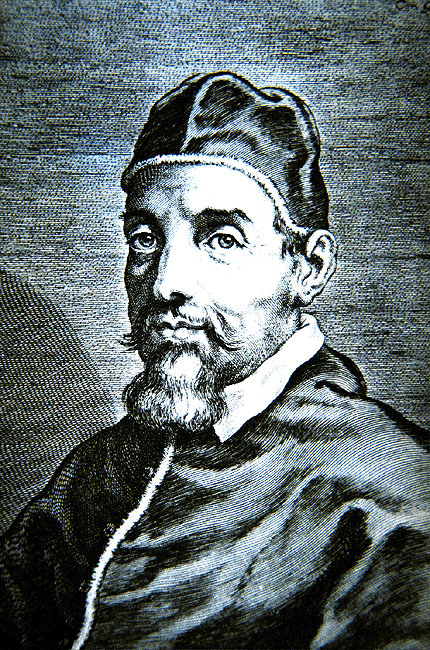 |
| An urbane Pope |
(*) Yeah, merely. "False" can be corrected with new data, and "contrary to Scriptures" can be fixed with new understanding. But "heresy" is serious weenie, a lot more so that "formally heretical," which in the Aristotelian schema meant "heretical in form" but perhaps not in matter.When Prince Cesi goes to congratulate Urban on his election, the Pope interrupts him eagerly: "Is Galileo coming? When is he coming?"
As soon as he can. As usual, his rheumatism is acting up. If only he could just stay on his villa and never have to travel! The next best thing to the Immovable Object is Galileo on his estate. But this is a special case and off to Rome he heighs.
Making an Assayer of Oneself
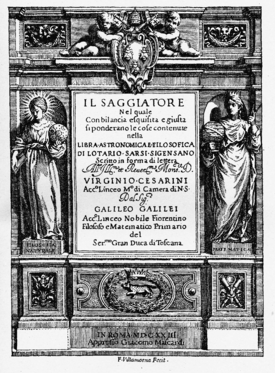 |
| Galileo makes an Assayer of himself |
Others, not wanting to agree with my ideas, advance ridiculous and impossible opinions against me; and some, overwhelmed and convinced by my arguments, attempted to rob me of that glory which was mine, pretending not to have seen my writings and trying to represent themselves as the original discoverers of these impressive marvels. (Galileo, The Assayer, p.232)This is a diss at Scheiner, who really had been convinced by Galileo's arguments regarding the nature of the sunspots, and who really had been the victim of "cross-posting" delays through Max Welser's translations.
Addressing "Sarsi" (Grassi), Galileo writes:
“You cannot help it, Signor Sarsi, that it was granted to me alone* to discover all the new phenomena in the sky and nothing to anybody else.”(*)So much for Harriot, Marius, Fabricius, Scheiner, and the rest. He also refers to Tycho’s “alleged observations” and calls comets “Tycho’s monkey-planets.” This manages to offend even Kepler. (Passing thought here: Did Galileo suffer from Aspergers?)
(*) me alone. One is irresistably reminded of the Wright Brothers and their claim that they had, in effect, a patent on all air flight. (TOF has just read an article in the Milwaukee Journal from 1904 in which the Wrights threatened to shut down a California air show for just this reason.) And just as the Wrights ceased to innovate in air flight, Galileo made no more big telescopic discoveries.There is much to admire in The Assayer. Leaving aside that the entire thing was an effort to justify a theory of comets that was entirely incorrect -- viz., that they are emanations in the Earth's atmosphere -- Galileo repeats the medieval trope that mathematics is the key to natural science, indeed the privileged language of science (cf. Grosseteste, Bradwardine, Oresme). He also expands on the Aristotelian problem of the common and proper sensibles, which he renames "primary" and "secondary" qualities, soon to be designated "objective" and "subjective." This is the squalling birth of the mechanistic metaphor used by Early Modern scientists, and the first squirt of "300 years of philosophical squid ink." Descartes and Hume are busily making many of the same points.
All of this is beside the heliocentric point, except for one thing. Someone will take amiss his comments on the sensibles. Wait for it.
Meanwhile, the Pope has The Assayer read to him at his dinner table and finds it highly enjoyable. That old guy can sure write.
Easter Monday 1624. Galileo arrives in Rome at last and the next morning is received by the Pope. Six interviews in seven weeks! Unprecedented favor! The Pigeons pull their hair. Urban promises a pension for Galileo’s son and a better chaplain for his daughter's convent. (Because, face it, Early Modern Italy is all about rent-seeking.) Galileo himself receives a fine painting, gold and silver medals, and other gifts. He is "In like Flynn," a condition which TOF assures Faithful Reader is very In indeed.
There is no record that they discuss the ban on Copernicanism-as-fact, although Urban does point out that as long as there is more than one model that can explain the same phenomena, each model must be regarded instrumentally. Even if men know of only one model, God might bring about the same results by some other means of which we know nothing. It's not enough to show that a replacement model is plausible, or even that it works better than the standard model. You have to show that if the replacement model were false it would lead to a contradiction. (Pope beats Popper by 300 years!) Then he makes a suggestion: Hey, dude, why not write a book setting out the arguments for and against each system?
Galileo thinks this is a keen idea.
7 Jun 1624. After meeting with Galileo, Prince Cesi, and Father Monster, German Cardinal Frederic Eutel von Hohenzollern (known to the relief of all non-Germans simply as "Zollern") pays his respects to the Pope before departing for his see at Osnabrück. He mentions the difficulties in converting German noblemen shocked by the suspension of Copernicus’ book in 1616, hoping to get a statement from him on Copernicanism. According to Zollern, the Pope answers that...
... the Holy Church had not condemned [Copernicanism] nor was she about to condemn it now as heretical, but only as rash. Though it was not to be feared that there would ever be anyone to demonstrate it as necessarily true.
Letter of Zollern (quoted in Shea/Artigas pp. 111-112.)
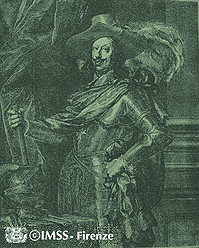 |
| Ferdy II, Galileo's new boss, is only 14 and the real boss is Granny Christina. |
Cardinal Zollern leaves with a compound microscope which Galileo has given him as a gift for Maximilian I, the Duke of Bavaria, who in 1623 was granted the title Prince-elector formerly belonging to the now-quashed Elector Palatine. (During the Thirty Years War.) Galileo had demonstrated the instrument for the Linceans, and one of them made a microscopic examination of a bee, the symbol of the Barberini family.
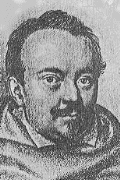 |
| Johnny Ciampoli |
Excursus: The Far-Seeing Look-Glass Goes to China
It's worth glancing aside at the impact of the telescope on China. About this time (1623), Johann Schreck, the seventh member of the Lyncean Academy, arrives in Peking with Adam Schall von Bell and other Jesuit missionaries. Schreck brings with him a new Keplerian telescope given him before his departure by Cardinal Borromeo. While in China, Schreck corresponds with leading European astronomers. Kepler will respond by sending his Rudolphine Tables. Galileo, as usual, does not reply. In 1626, Schall von Bell will write Treatise on the Telescope in Chinese and review all of the discoveries of “a celebrated [but unnamed] Western astronomer.” Convert Wang Cheng (a.k.a. "Dr. Philip") will write (1627) Diagrams and Explanation of the Marvelous Devices of the Far West, in which he points out the telescope’s usefulness in navigation, warfare (you can count enemy horses at a far distance), painting, the camera obscura, etc. Dr. Phil has a hard time explaining about lenses because there are at the time no words in Chinese for concave or convex. China does not have the technology to grind lenses for eyeglasses or telescopes, and their understanding of optics has not yet reached that of al-Haytham (d.1038). Fr. Schall will later (1664) be imprisoned and tortured for "unauthorized use of a telescope," and the Chinese assistants who had converted to Catholicism will be beheaded. Tell Schall how tough Galileo had it. Interestingly, the telescope triggers no Scientific Revolution in China.
Johnny Schreck, 7th member
of the Lincean Academy,
shown here as mandarin
of the Imperial Chinese
bureau of astronomy.
J'Accuse!
 |
| The unsigned, undated document claiming that the atomism in The Assayer sheds doubt on transubstantiation. Slide: Shea/Artigas |
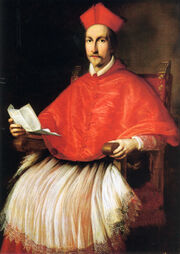 |
| Pope's nephew a cardinal! So is a brother and another nephew! What a coincidence! |
Well, maybe. Some people will use any stick to beat a man who is down. Galileo himself had once cleared Simon Marius of a charge of plagiarism; and then turned around years later and used that charge against him when he thought Marius was stealing his thunder moons-of-Jupiter-wise. Scholars are not certain what role this G3 document will play in the minds of the tribunal during the famous trial. In any case, it is a far more serious charge than saying that Scripture passages regarding the Earth's immobility are probably figurative.
24 Jun 1626. A disgruntled army of 70,000 peasants flying black banners bearing a death's head and the words "It must be" march on Linz, the capital of Bavarian Austria*, where Kepler is trying to finish his Rudolphine Tables. This is a vexing interruption. Kepler moves to Ulm, where he arranges for the printing of the Tables at his own expense.
(*) peasant army, Bavarians in Austria. It's a long story. See, Thirty Years War.
1627. Kepler's Rudolphine Tables are finally printed, calculated from thirty years of raw observational data accumulated by Tycho Brahe . In his age, this was regarded as Kepler's finest work. He calculates transits of Mercury (7 November) and Venus (7 December) in 1631. What is now needed is an observational astronomer with the pluck and luck to observe the event and confirmation the efficacy of the elliptical orbits. Pluck is required because Kepler’s calculations were not precise enough to predict the exact time of transit so the astronomer must observe over a long period time to catch the transit. Luck is required to deliver good observing conditions at the required time.
1628. Kepler becomes an official advisor to Albrecht Wenzel Eusebius von Wallenstein (known mercifully as Wallenstein), providing astronomical calculations for Wallenstein's astrologers and occasionally writing horoscopes himself. Wallenstein is the captain-general of the Imperial Hapsburg armies and has successfully kicked Danish butt right out of the war.
The Dialogue of the Deaf
 |
| Galileo is a highbrow. Slide: Shea/Artigas |
1624-1629. Galileo (60) returns to Florence loaded for bear. He is convinced his BFF has given him the green light to write his Dialogue on the Two Chief World Systems on the motion of the Earth -- provided he doesn't flat out say that it's physically true. He plans the book as a discussion among three friends who meet in a palace in Venice.
- Filippo Salviati, Galileo's late Florentine friend, who speaks on Galileo’s behalf and argues for Copernicanism.
- Giovanfrancesco Sagredo, a late Venetian patrician, and also a dear friend of Galileo. He is presented as open-minded, but is clearly already a believer in Copernicanism. It is in his palace that the dialogue is set.
- Simplicio, a fictional composite apparently modeled on Ludovico delle Colombe, who argues for the Ptolemaic model. Simplicius, a 6th cent. Greek philosopher, wrote a famous commentary on Aristotle. In Italian, Simplicio also sounds like "simpleton," and Galileo could never pass up a pun.
 |
| Dig them crazy epicycles! |
So Galileo keeps looking for that knock-out punch: the empirical proof that would demonstrate geomobility as physical reality. There is plenty of evidence that heliocentrism might be true; but all of that evidence would apply just as well if the Tychonic model were true. This is because the two models are mathematically equivalent, differing only in their respective inertial reference frames.
| Tychonic model matched the data but Galileo thought it looked klutzy. |
The Ursine model is like the Tychonic, but with a rotating Earth. For some reason, physicists were more willing to consider a diurnal rotation than an annual revolution. They are mind- hobbled by the notion that a body could have only one natural motion. Copernicus had proposed three -- a bit cheeky of him -- but Tycho has already shown that the third motion was bogus - due to measurement error.The Sunspot Track. At first Galileo thinks the path of the sunspots prove the Earth moves. They trace a straight line across the Sun’s face only during Earth’s solstices. If the Earth circles a Sun inclined to the ecliptic, this semi-annual cycle makes sense! But in 1629, Fr. Scheiner accounts for sunspot paths more accurately and deduces the Sun’s inclination while retaining a stationary Earth. It makes sense the Tychonic way, too! (Look. Nothing mathematical is ever going to settle this.)
The Answer to the Parallax. Galileo thinks he has answered the parallax problem, too. The stars are much, much farther away and the parallax is thus too small to see. But you cannot prove one hypothesis by assuming a second, unproven hypothesis. Stars seen through telescopes of small aperture, such as those used in the 17th century, “appear as well-defined, albeit entirely spurious, disks,” which argues against the Copernican model for the same reasons Tycho had given decades earlier. (See Part 1.) Telescopic resolution isn’t yet up to the task. (Graney, 126 Arguments Concerning the Motion of the Earth)
 |
| Stellar image from
Herschel, 1848, seems to have a diameter! |
Now, Galileo was right on. The stars really are much farther away than supposed, but science requires demonstration, not bald assertions, lucky guesses, or what amounts to a patch on the system. There were good reason why the stars had to be close. If they were too far away, their apparent diameters would, through simple geometry, imply that all stars are so enormous as to dwarf not only the Sun, but the solar system as well. George Biddell Airy will not prove that these discs are merely diffraction patterns until 1835.Like everyone else, Galileo thinks that the size and brightness of a star indicates its distance, just as today we think the red shift of galaxies indicates their distances. He proposes that we can test his theory by finding an optical double: two stars with small angular separation, but where one is large and bright (hence, "close") and the other small and dim (hence, "far"). If the Earth revolves around the Sun, the parallax in such a pair should be detectable!
"For I do not think the stars are lying on a spherical surface equidistant from the center, but rather I judge that their distances from us vary to such an extent that some may be two or three times farther than others; hence, if the telescope should reveal some very small and very distant star very close to one of the largest, it could happen that they would exhibit some perceivable variation corresponding to that of the superior planets." -- Galileo, DialogueTwo or three times farther. Oh, my. Alas, he tries it himself and fails to find the predicted parallax and does the clean, manly Renaissance thing: He keeps his mouth shut. This does not stop him from touting the test in the Dialogue. Dammit, it should have worked. Poor Galileo did not realize that there are actual binary stars and he has had the bad luck to pick one, Mizar, where the two stars are essentially the same distance. Bummer.
 |
| Yes. Galileo was once a young perfesser, a "patrician of Florence" |
There is a Tide in the Affairs of Men.
Finally, Galileo falls back on the Argument of the Tides, which had first convinced him of Copernicanism back in 1597, when he saw the water in the drinking barrel slosh about as he rode a barge in Venice. He wrote to Kepler that the Copernican doctrine could explain the tides. (Some authors say that he got the idea from his friend Sarsi.) In 1616, when Copernicus was suspended for a few years, Galileo had presented this as physical evidence of geomobility in a private letter to Cardinal Orsini. Orsini, quite excited, urged him to work it up in detail and publish it.The theory was basically that the dual motions of the Earth cause the oceans to slosh about, like the water in a barrel on a barge. And never mind that this actually contradicts his own theory of dynamics. Kepler says the Moon causes the tides by somehow "attracting" the oceans, but Kepler is a mystical loon, and this "attraction" strikes Galileo as weirdly occult.
No theories grip us more than the theories we developed in the flush of our youth, either our very own brainstorms or ideas we learned in school from beloved teachers. Since this theory had convinced the young Galileo, he thought it ought to convince everyone.
"I have taken up work again on the Dialogue of the Ebb and Flow of the Sea ... I trust, a most ample confirmation of the Copernican system."
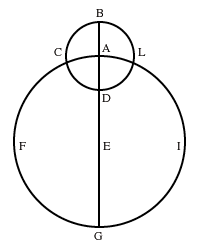 |
| Galileo's model of the tide mechanism Looks damned familiar, Ptolemy. |
Let's not be too hindsightful. Grassi, who had been slimed by Galileo, takes a contrary view and this is interesting because it explodes the notion that in any controversy of this sort, one guy is right and uses Science!™ while the other dude is wrong and relies on Tradition, Superstition, and Aristotle. In fact, both Grassi and Galileo performed similar experiments and the outcomes were, from our perspective, compatible with both men's conclusions. Paolo Palmieri has replicated their experiments in Re-examining Galileo’s Theory of Tides:
Grassi’s conception of the same phenomena stuck to the Aristotelian creed of the crystalline spheres. Yet, the outcome of my experiments is strictly in accordance with the observations reported by both Grassi and Galileo. As I shall argue, this shows that Galileo’s interpretation of the ‘dragging’ effect occurring near the wall of a rotating vessel as being due only to a local phenomenon caused by friction was supported by the evidence furnished by his experiment, but it also makes clear that Grassi’s objections, based on more complicated, though not conceptually equivalent, versions of the Galilean experiment, were not naive at all. On the contrary, they were certainly established on the sound basis of a genuinely experimental attitude that clearly emerges from behind the scenes of Grassi’s preoccupation of saving the ‘old’ cosmology of the solid celestial orbs.In other words, both men were sincerely trying to understand nature through experiment, but were viewing the data from different preconceptions. It was not Science vs. Humanism; it was Science vs. Science. Duhem gives an example of this with two (then) modern physicists conducting an experiment involving pressure, in which one of them uses the theories of Laplace and the other the theories of Lagrange. The selfsame experiment confirms for one the same hypothesis it falsifies for the other.
Gitchee Mantua
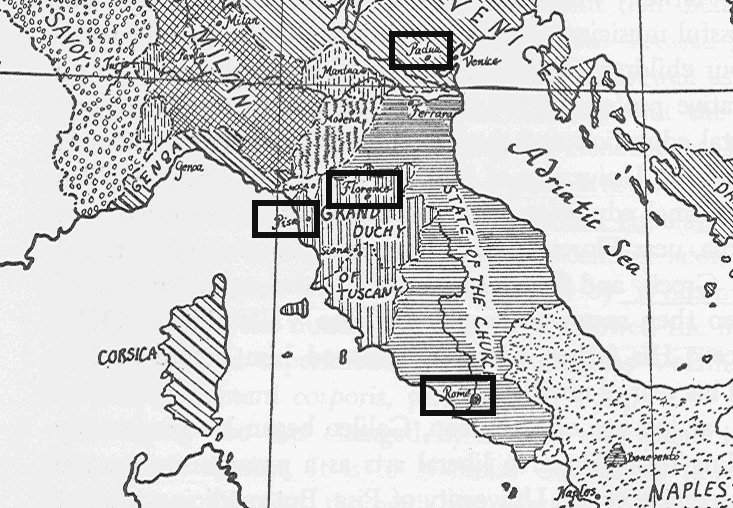 |
| Mantua: three pieces in vertical dashed lines. Big one directly west of Padua (black rectangle, upper right). Two little pieces on the other side of Milan, between it and Savoy and north of Genoa. Milan is controlled by the Spanish Hapsburgs. |
March 1629. Bourbon pours across the Alps, igniting the War of the Mantuan Succession, one of the side-show wars orbiting the Thirty Years War in Germany like TIE fighters around the Death Star. The casus belli is too dynastically convoluted to discuss here; but note on the map above the proximity of the war to the Papal State and the Grand Duchy. Savoy, Venice, and the Papal State are hostile to Hapsburg interests. Later that year, Imperial troops arrive from Austria and in their wake plague breaks out. The Pope raises and equips 7,000 infantrymen and 800 cavalry, which forces him to raise taxes, which affects his popularity.
1630. Christoph Scheiner publishes his Rosa Ursina, which will remain the definitive work on sunspots for over a century. Book One is a final flame against Galileo, countering Galileo's claims of plagiarism against him and reasserting his (Scheiner's) independent and prior discovery of sunspots.* The remainder is "a detailed critique of the incorruptibility of the heavens and other Aristotelian assumptions," coupled with "the most valuable treatise on solar physics of that epoch." Warned by Ciampoli (via Castelli)** not to offer any comment, perhaps to avoid any further hoo-hoo with the Jebbies, Galileo bites his tongue and continues with his own writing.
(*) prior discovery of sunspots. Probably so, but Fabricius beat them both.1630. Also this year, Christoph Scheiner builds a telescope based on Johnny Kepler's1611 design. Kepler’s design reduces spherical aberration by replacing Galileo’s concave lens with a convex lens. The long delay between Kepler's theory and Scheiner's actuality indicates that it was no piece of cake.
(**) Ciampoli to Castelli to Galileo. Like Tinker to Evers to Chance. From Papal secretary in Rome to math professor in Pisa to courtier-physicist in Florence.
Feb 1630. Urban VIII bestows a pension of 40 scudi per year on Galileo.
Apr 1630. Galileo finishes his Dialogue Concerning the Ebb and Flow of the Sea.
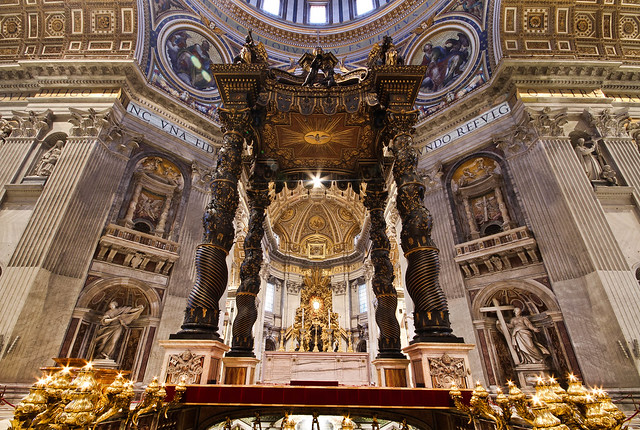 |
| Bernini's baldacchino |
(*) Father Monster is Niccolo Riccardi's nickname because of his considerable size. "Niccolo" is of course his Nicc-name. LOL!18 May 1630. The Pope returns from Castelgandolfo and Galileo receives an immediate audience with his old friend. But it is the only one during the eight-week visit. Urban is very must distracted by domestic dissent and foreign affairs.
18 May 1630. On the same day, the gossip sheet Avvisi -- which would have been a sort of 17th century supermarket tabloid had the 17th century had supermarkets -- reports the tidbit that: “Galileo, the famous mathematician and astronomer, is here to try to publish a book in which he attacks several opinions held by the Jesuits. He has been understood to say that D. Anna. [Colonna, the wife of Taddeo Barberini, the Pope’s non-cardinal nephew] will give birth to a son, that we shall have peace in Italy at the end of June, and that shortly thereafter Taddeo and the Pope will die.” One of the reasons casting horoscopes was frowned upon is that it was often a channel for political dissent, and "forecasting" the death of a Prince in Machiavellian Italy is not the safest of occupations. Galileo has cast no such horoscope, but...
26 May 1630. ...he has dinner with the man who did, Fr. Orazio Morandi. Another guest at the same dinner is Fr. Raffaello Visconti. Can we say "guilt by association"? TOF knew we could.
3 Jun 1630. Galileo asks his friend Michelangelo, nephew of the late sculptor, to speak to the Pope’s nephew, Cardinal Francesco Barberini about the Avvisi item. But before Michelangelo can so much as mention the gossip, the cardinal cuts him short. He does not believe a word of it and says that Galileo “has no better friend than the Pope and himself.” (Shea/Artigas 2003, p. 140).
 Having realised that the Dialogue would be read as
sympathetic to Copernicanism, the first thing Fr. Monster does is insist
on adding a preface and conclusion that emphasize the
hypothetical nature of the study and hence showing "that the Holy
Congregation in reproving Copernicus had acted in an entirely reasonable
way." He then gives the manuscript to Raffaello Visconti,
Master of the Sacred Palace who is also a professor of mathematics -- and a dinner guest the week before at Morandi's. Visconti
approves the preface and conclusion. Riccardi is still not happy. He
learns that Urban is annoyed at the claim that
the tides depend on the motion of the Earth. Riccardi
decides to review it himself and discusses it with the Pope, who
insists that the title no reference to the ebb and flow of the sea
but instead should speak of the "Chief World Systems", or something
similar. The Dialogue Concerning the Ebb and Flow of the Sea becomes The Dialogue Concerning the Two Chief World Systems.*
Having realised that the Dialogue would be read as
sympathetic to Copernicanism, the first thing Fr. Monster does is insist
on adding a preface and conclusion that emphasize the
hypothetical nature of the study and hence showing "that the Holy
Congregation in reproving Copernicus had acted in an entirely reasonable
way." He then gives the manuscript to Raffaello Visconti,
Master of the Sacred Palace who is also a professor of mathematics -- and a dinner guest the week before at Morandi's. Visconti
approves the preface and conclusion. Riccardi is still not happy. He
learns that Urban is annoyed at the claim that
the tides depend on the motion of the Earth. Riccardi
decides to review it himself and discusses it with the Pope, who
insists that the title no reference to the ebb and flow of the sea
but instead should speak of the "Chief World Systems", or something
similar. The Dialogue Concerning the Ebb and Flow of the Sea becomes The Dialogue Concerning the Two Chief World Systems.*(*) Actually, that title came later, in 1744. The original title was much snappier:
Dialogue of Galileo Galilei, Lincean, Special mathematician to the University of Pisa and Philosopher and Chief Mathematician to the Most Serene Grand Duke of Tuscany, where, in the meetings of four days, there is discussion concerning the two Chief Systems of the World, Ptolemaic and Copernican, propounding inconclusively the philosophical and physical reasons as much for one side as for the other...,You like that propounding inconclusively part? How about as much for one side as for the other?
26 Jun 1630. Satisfied that the imprimatur will be granted, Galileo returns to Florence. But Perceptive Reader will realize that only the Preface and Conclusion have been reviewed. Fr. Monster had enthusiastically approved The Assayer but is now being asked “to buy a pig in a poke.” He hasn’t read The Dialogue.
“Manipulating Father Riccardi, always so anxious to please, did not seem to them to be objectionable. Hoodwinking Cardinal Francesco Barberini or, worse still, the pope, however unwittingly, was another matter.” (Shea/Artigas 2003, p. 133)
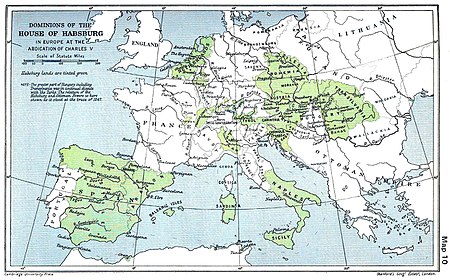 |
| How green was my Hapsburg |
July 18, 1630. Mantua is sacked by Imperial (Hapsburg) troops. (So much for the horoscope...)1 Aug 1630. Prince Federico Cesi, the founder and patron of the Lincean Academy, dies leaving neither will nor successor at the Academy. Effectively, the Lincean Academy, Galileo's publisher, dies with him.
Crisis! Prince Cesi had planned to cover the expenses of publishing. Castelli suggests to Galileo that he publish in Florence instead. Fr. Riccardi says he will need a copy first in order to correct it, after that Galileo can publish it wherever he pleases. But the plague is raging across Italy, impeding both travel and post, so Galileo asks to amend the work in Florence and forward only the preface and conclusion to Riccardi in Rome for his consideration. Medici muscle is employed: Ambassador Niccolini's wife, Caterina Riccardi, leans on her cousin, Fr. Monster. Riccardi finally agrees, with the caveat that the final draft be reviewed by a qualified Dominican. Galileo suggests Fr. Jacinto Stefani, a consultant to the Florentine Inquisition. Fr. Monster is unsure.
13 Aug 1630. Wallenstein is fired by the emperor Ferdinand who has become (justly) wary of his ambition.
13 Oct 1630. The Treaty of Regensburg kinda sorta ends the Mantuan war on terms favorable to the Bourbon interests.
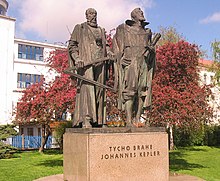 15 Nov 1630. Kepler falls ill shortly after moving from Ulm to Regensburg. He dies and is buried there,but his burial site
is lost after the Swedish army destroys the churchyard. Kepler's writes
his own epitaph:
15 Nov 1630. Kepler falls ill shortly after moving from Ulm to Regensburg. He dies and is buried there,but his burial site
is lost after the Swedish army destroys the churchyard. Kepler's writes
his own epitaph:Mensus eram coelos, nunc terrae metior umbras
Mens coelestis erat, corporis umbra iacet.
I measured the skies, now the shadows I measure
The mind was celestial, the body prostrate in shadows
17 Nov 1630. Caterina Riccardi reports that Fr. Riccardi has agreed reluctantly to the publishing arrangements. Fr. Stefani "declares, as all those who have read the book, that I [Galileo] should have been begged to publish such a work rather than hindered." (per Galileo, letter to Cioli, 7 Mar 1631)
30 Nov 1630. Castelli assures Galileo that Fr. Monster has promised to expedite the Dialogue and entrust the matter to Fr. Stefani. Oh, by the way, Fr. Visconti, who read and approved the Dialogue is in deep kimchee, having gotten mixed up in that business of the horoscope predicting the Pope's death. The author of the horoscope, Fr. Orazio Morandi, has been thrown in prison.* Visconti has been banished. You remember Morandi: you had dinner at his house just before that horoscope came out.
(*) thrown in prison. The eventual outcome will be the Papal Bull Against Astrologers.
Winter 1630/1631. The plague continues. Clothing burned. People shut up in quarantine. Seven thousand in Florence die out of a population of 70,000. Board of health declares a general quarantine; people and bishops want to gather to pray. Quarantine postponed to after Christmas season. All people confined to home. Galileo hears nothing from Rome because no one is traveling. He grows frustrated.
15 Feb 1631. Happy Birthday, Galileo. Your brother is dead (in Munich). Galileo is 67.
6 Mar 1631. The quarantine is lifted for men, and Galileo hustles to the ducal palace to complain that he has not heard from Fr. Riccardi. How could he let a little thing like plague and quarantine get in the way of approving Galileo's book! The next day he complains in writing to Andrea Cioli, the Tuscan Secretary of State, about Riccardi's foot-dragging. He claims (incorrectly) that Fr. Monster has read the entire text, and forgets to mention that the subject is controversial or that he had been admonished in 1616 not to hold Copernicanism as physically real.
Cioli brings the matter up with the Grand Duke (now 19, and tutored by Galileo) who orders Ambassador Niccolini to exert Medici muscle on the Master of the Sacred Palace. Niccolini doesn't want to get involved. Like Fr. Monster, he is well aware of the political climate in Rome and how sensitive the publication is likely to be. He sends his wife to muscle her cousin.
16 Mar 1631. Niccolini reports that Riccardi's hesitation stems from Fr. Stefani being the reviewer rather than his own choice the mathematician-priest Fr. Del Nente.
5 Apr 1631. Niccolini asks for more time. Cioli says get a move on; the Grand Duke wants this to happen, toot sweet.
13 April 1631. The Battle of Frankfurt-an-der-Oder heralds the entry of Sweden into the Thirty Years War. Just when you thought it was safe to go back in the German waters, along comes this religious nut who may not even realize that the real war is a Bourbon effort to bring down House Hapsburg.* Gustavus Adolphus is off to make the world safe for Minnesota Lutheran meat loaf. Everyone checks their
Gustaf II Adolf watchescalendars and sees that there are seventeen years yet to go. The damn war isn't even half over yet!
(*) Bourbon-Hapsburg. The times, they are a-changing. At White Mountain the Imperials charged into battle shouting "Sancta Maria!" At the Battle of Nördlingen (1645) they will charge into battle shouting "¡Viva España!" New gods are replacing the old to prep for the holocaust of 1914 et seq.14 Apr 1631. Niccolini and Riccardi meet at last and have a "battle," the upshot of which is that each promises a letter absolving the other of any blame if trouble results. "The truth is," Niccolini writes back, "that these opinions are not received well here, especially by the Authorities." Riccardi does not think Fr. Stefani knows the Pope's mind on this and so cannot review the text properly; but he finally agrees that he will send instructions to the Florentine Inquisitor, Clemente Egidi, and will himself personally check the opening and closing sections (again).
Galileo is "disgusted" (in a note to Cioli). From his POV, Riccardi has made him wait a full year, and is now going the same route with the Grand Duke. He wants a public commission chaired by the Grand Duke and including Cioli and the Florentine Inquisitor.
24 May 1631. Riccardi buckles at last under the political pressure. He absolves himself of all responsibility and passes the imprimatur buck to Egidi. Since the book cannot be sent to Rome, the vetting must be done locally. But there are some things that the Inquisitor must know:
- The title must make no mention of the tides
- If Scripture is not taken into account, Copernicanism may be presented as a theory that accounts for the data, with no claim regarding its physical reality.
- The book is being written to demonstrate that Rome does not condemn Copernicanism without knowing all the arguments in its favor.
"With these precautions, no one in Rome will object to the book, and you will be in a position to please the author and serve His Highness the Grand Duke, who has shown such concern in this matter."
Publish or Perish! Or Both?
June 1631. Presuming that imprimatur is now a done deal, Galileo has the printer begin printing the main text. It is about 10% done when...19 July 1631. After pestering from Niccolini, Riccardi finally sends the Preface, allowing Galileo to reword it as long as he keeps the substance. "The same argument must appear in the conclusion," he writes. And that means he has buckled before reading the Conclusion, which contains the Popperian and instrumentalist views of Pope Urban on the nature and limits of scientific theory. Had he read it, he might have seen that those views had been placed in the mouth of the doofus, Simplicio; though even then, without the context of the main text, he might not have seen what a slap in the papal face with a wet fish it was.
For someone who had read the Dialogue from the beginning, the passage ... was unmistakably ironical, although taken in isolation and without awareness of what comes before, it might pass muster. (Shea/Artigas)A social climber like Galileo is surely not foolish enough to do this on purpose, but he may have been vain enough to suppose that no one would notice. He never could resist a zinger.
Which was not a good idea in Machiavellian Italy.
16 Aug 1631. Galileo writes to Diodati in Paris to tell him that he has permission to publish his book, provided he does not mention the tides in the title.
"Although this [the tides] is the main argument... But I have been allowed to outline the Ptolemaic and Copernican systems and say all that can be said for both of them without coming down on one side."He doesn't get it. He thinks all he needs to do is for his characters to refrain from formally endorsing geomobility. But the Pope's objection are deeper: no scientific theory can ever be demonstrated with certainty and can be held only as instrumentally useful. He had wanted the weaknesses and uncertainties of Copernicanism highlighted as well, so that the Church's defense of the consensus view will seem prudent. Galileo typically underestimates his opponents' chops. That is a chasm into which a whole lot of people can fall.
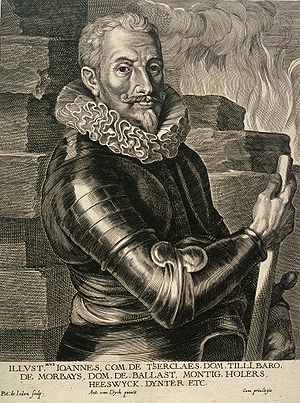 |
| Count Tilly meets his match. |
17 Sep 1631. Count Tilly is defeated and killed at Leipzig (Breitenfeld) by Swedish forces under Gustavus Adolphus. This is the first major rebel victory. The Emperor recalls Wallenstein.
 |
| Fr. Pierre Gassendi |
7 Dec 1631. Gassendi's luck deserts him as the Venus transit of the Sun occurs in the night in Paris his observational position.
 |
| Try running off a thousand copies of hundreds of pages on this baby! |
Praise be to God, today I finished Galileo's book, which will be presented to the Grand Duke and the Princes tomorrow.Galileo cannot wait for the reaction to his magnum opus, but...
Got Troubles on My Mind
Urban has other concerns. The Thirty Years War is fourteen years old and the Papacy favors the French Bourbons while trying not to annoy the Spanish and German Hapsburgs too badly. The Hapsburgs rule in Milan and the Two Sicilies, with the Papal State smack between. The Spanish cardinals, especially Gasparo Borgia, openly dissent from the Francophile policy.8 March 1632. At a consistory of the cardinals (a cabinet meeting), Cardinal Gasparo Borgia denounces Urban for supporting the “Protestant” side in the Thirty Years War and the pro-Hapsburg and pro-Bourbon cardinals get into a fistfight. The Swiss Guard is called to restore order; and from then on, Urban sees Hapsburg plots everywhere. Galileo’s friend and supporter, Msgr. Ciampoli is discovered to be in league with the pro-Spanish faction, while Galileo’s patron, the Grand Duke of Florence, is an ally of the Austro-German Hapsburgs. And Florence has claims on Roman territory, the Duchy of Urbino.
Domestically, the Roman public is disgruntled with the Barberini family over taxes, and horoscopes are being cast against them predicting an early fall from power. The last thing Urban needs is some piddling hoo-hah over astronomical mathematics.
Then someone points out the apparently gratuitous insult offered in the conclusion of the Dialogue.
And the rest is history.*
(*) the rest is history. OK, technically, so is everything else so far.
Denoument
TOF's Faithful Reader may realize that by this time, both Ptolemy and Copernicus are out of the race, which is now between the Tychonic/Ursine models and the Keplerian model. But the phases of Venus showed empirically that the Ptolemaic model was wrong. So why is Galileo beating a dead horse?Maybe because he is trying to do physics, not astronomy, and is concerned only with whether the earth moves, not with the details? Right now, the Ursine model is "ahead on points," but Kepler is coming up fast on the outside; esp. now that the Rudolphine Tables are out and astronomers are finding them easier to use while getting good forecasts. (Recall that both Ptolemy and Copernicus had used the old Alphonsine Tables, which had been corrupted by copyist errors over the centuries.) Following a suggestion by Gilbert, Kepler had postulated that the sun puts out some kind of magnetic force that chivvies the planets along, so he was on the way to an ur-Newtonian theory. But Kepler is quieter than Galileo. In fact, being dead at this point, he is really really quiet. When he wasn't running from a besieging army, he worked as Imperial Mathematician for the Holy Roman Emperor with nary a peep from the Authorities, even though he was just as strong an advocate for geomobility. Quietly and with little fuss, the Keplerian model is gaining adherents and providing demonstrations that geomobility is a viable theory, while Galileo makes noise and provides no actual demonstration that advances the cause.
Next: Part 8. Trial and Error
References
- Chastek, James. (2006) The givenness of the proper sensibles
- Christie, Thony. (2013) The speed of light, a spin off from longitude research.
- Christie, Thony. (2011) A small spot in front of the sun, a small step down the road to heliocentricity.
- Christie, Thony (2013) Galileo not admitting he was wrong
- D'Addio, Mario. The Galileo Case: Trial, Science, Truth. Gracewing Publishing, 2004.
- De Santillana, Giorgio. The Crime of Galileo. Chicago: University of Chicago Press, 1955.
- Duhem, Pierre. (1892) Some reflections on the subject of physical theories in Essays in the History and Philosophy of Science (ed. Roger Ariew and Peter Barker)
- The Galilean Library. Non-Intellectual Contexts.
- The Galileo Project. Chronology.
- Gigli, Rossella. (1995) Galileo's Theory of the Tides
- Graney, Christopher M. (2011) 126 Arguments Concerning the Motion of the Earth.
- Linder, Douglas. The Trial of Galileo.
- Mayer, Thomas F. (ed.) The Trial of Galileo, 1612-1633. University of Toronto Press, 2012 (includes translations of basic documents in the case; a textbook for law)
- Rowland, Wade. Galileo's Mistake. New York: Arcade Publishing, 2003.
- Sant, Joseph (2012). Jesuits and the Early Telescope: Scheiner and Grienberger.
- Sharratt, Michael. (1994) Galileo: Decisive Innovator
- Shea, William R. and Mariano Artigas. Galileo in Rome. Oxford: Oxford University Press, 2003.
- Shea, William R. and Mariano Artigas. The Galileo Affair. A short summary of #17, with slides.
- Palmieri, Paolo. Re-examining Galileo’s Theory of Tides. Arch. Hist. Exact Sci. 53 (1998) 223–375
- TOF (2011). The Far Seeing Looking Glass Goes to China
- Wedgwood, C.V. (1938, 1995) The Thirty Years War. (Book of the Month Club reprint)




However, Tycho's heir, Regiomontanus, argues that Tycho's data used to compile the tables are proprietary and a legal dispute delays publication.
ReplyDeleteBy 1623 Regiomontanus, who was not a relative of Tycho's, had been dead for 147 years! The man who caused Kepler unending grief about the ownership of Tycho's data was his son in law Frans Gansneb genaamd Tengnagel van de Camp. This dispute took place directly following Tycho's death in 1601 and dragged on for several years. It was finally settled with Tycho's family retaining ownership but Kepler obtaining publication rights, with Tengnagel holding the right to edit anything Kepler chose to publish; a right that he never exercised.
I'll fix that.
DeleteWill you be assembling these into an ebook? I would buy it in a heartbeat.
ReplyDeleteIt's mostly other people's thoughts.
DeleteIsn't it plagarism if a person takes ideas from one source and research if a person take ideas from many sources?
DeleteVery much enjoying this series.
A blessed feast day to you, Michael!
ReplyDeleteAfter the season of summer with its soft breezes,
when Zephyr goes sighing through seeds and herbs,
right glad is the grass that grows in the open,
when the damp dewdrops are dripping from the leaves,
to greet a gay glance of the glistening sun.
But the Harvest hurries in, and hardens it quickly,
warns it before winter to wax to ripeness.
He drives with his drought the dust, till it rises
from the face of the land and flies up aloft;
wild wind in the welkin makes war on the sun,
the leaves loosed from the linden alight on the ground,
and all grey is the grass that green was before:
all things ripen and rot that rose up at first,
and so the year runs away in yesterdays many,
and here winter wends again, as by the way of the world
it ought
until the Michaelmas moon
has winter's boding brought;
Sir Gawain then full soon
of his grievous journey thought.
-"Sir Gawain and the Green Knight", trans. J.R.R. Tolkien
"Galileo typically underestimates his opponents' chops. "
ReplyDeleteSo maybe he is the father of modern Science after all?
Ditto on getting this whole thing in one tidy buy-able package.
"If only he could just stay on his villa and never have to travel!"
ReplyDeleteLet me add my vote of appreciation for this excellent series!
"Then someone points out the apparently gratuitous insult offered in the conclusion of the Dialogue. And the rest is history."
ReplyDeleteWait - you're not ending here, are you? At the very least, could you explain what it was that the Church recently apologized for? That some legendarily proud and thin-skinned 17th century Italian Catholic leaders weren't heroically virtuous enough to let Galileo's lifetime of digs, snubs and faux pas slide, once they had a shot at him? Isn't this one of those 'I'm shocked! Shocked!" moments?
Plus, I don't want it to end.
Two more episodes: one last one on the trial, and then a return to the triumph of heliocentrism.
DeleteOne tiny quibble, Mr. Flynn. When the the Rudolphine tables were published the eponymous Emperor was no longer Kepler's employer, having been dead these ten long years. I mention this not out of pure pedantry (although I am quite capable of that, too), but to turn aside the conclusion people might draw that the naming was motivated by a desire on Kepler's part by a reward for the flattery (in parallel with, say, the naming of the Medician moons)
ReplyDeleteQuite right. I think Kepler was showing his gratitude for the late emperor's unstinting support, not kissing kaiserly butt.
DeleteI doubt that Ptolemy used the Rudolphine tables. I know what you meant, but still...
ReplyDeleteAlso, it's Rudolphine, not Rudolphone. But you knew that. (Just forgot it for a bit.)
Cheers.
They are the RudolphOne tables if you talk about them. Buy that? No? OK, I fixed.
DeleteBut, they might be RudolPHONES, if you talk *on* them.
ReplyDeleteI'm looking forward to finishing out this series. Great job.
BTW, I thought Eifelheim was great (I've even given a copy as a gift), and I'm trying to decide which of your books to pick up next.
If you have read it, do you have an opinion on Jerome Langford's Galileo, Science & the Church?
a) Nope, never read it.
Deleteb) If you want a stand-alone book, you might try THE WRECK OF THE RIVER OF STARS, which is phat nasty. It was what they call a "critical success."
c) Otherwise, there is THE JANUARY DANCER, which is the "hobbit" book for the Spiral Arm trilogy. Nice things have been said about it. The other books in the series are UP JIM RIVER, IN THE LION'S MOUTH, and ON THE RAZOR'S EDGE. They are far future space opera with a Celtic twist.
Thanks for the suggestions. I'll pick up/download The Wreck of the River of Stars.
DeleteI've just started The Wreck of the River of Stars. The writing is great. On just about every page, there's a sentence that I read twice, just to savor the sounds and thought.
DeleteYou are most kind.
DeleteReferring to Gustav Adolphus as a religious nut was a bit bizarre. This is the guy who is supposed to have said that if he were fighting a war of religion he would have declared war on the Pope.
ReplyDeletei'm eleven. make one one ptolemy that kids can understand.
ReplyDeletei'm eleven. make one on ptolemy that kids can understand.
ReplyDeleteI've been re-reading this fine series of posts, and was struck this time by Galileo's sense of self-importance. Then I remembered that he was an astrologer, and has surely done his own horoscope. This seems to me a very obvious source for sentiments such as that certain planets and phenomena were "destined" to be discovered by him.
ReplyDeleteI suppose this is one reason why the Church condemns astrology.
Do you by any chance know if we have a source to Galileo's horoscope as laid by himself?